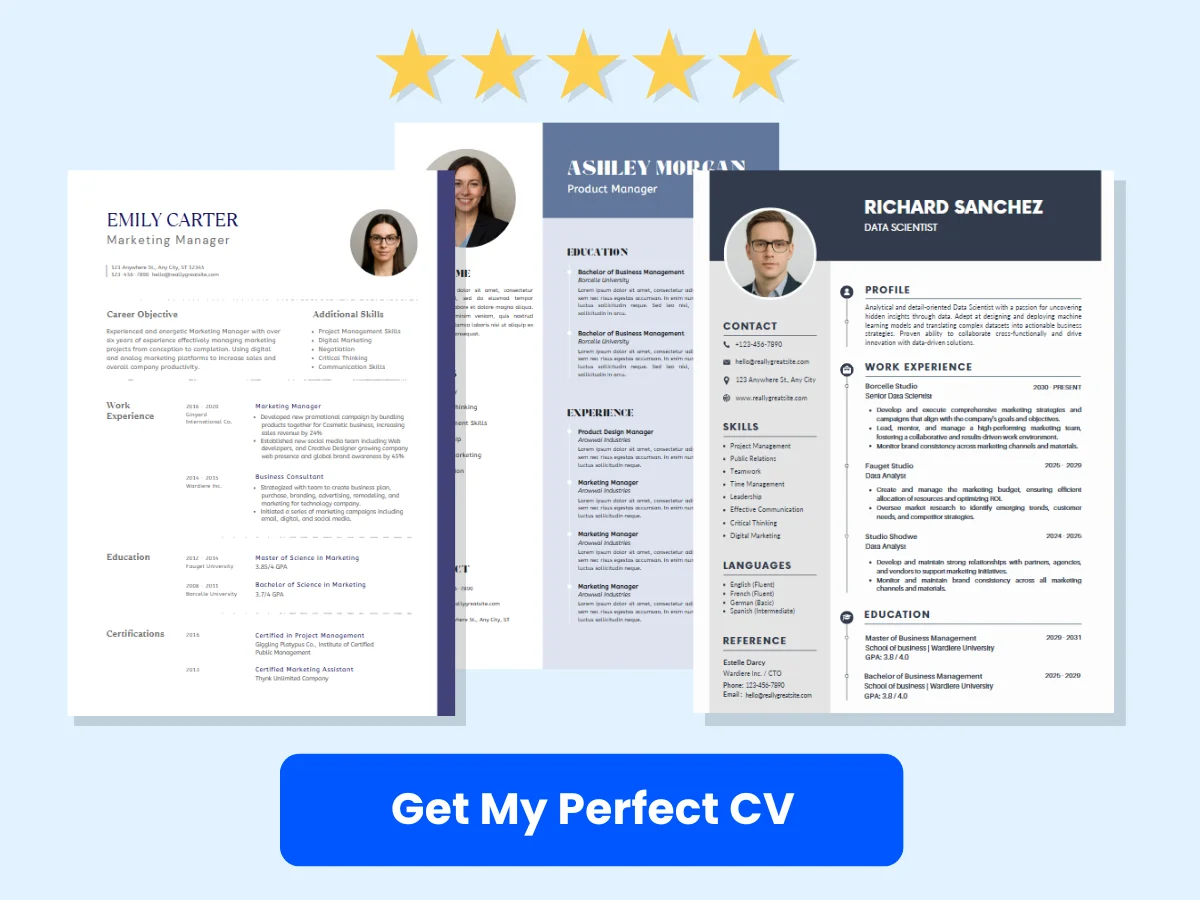Crafting a standout CV is more crucial than ever. One of the most effective strategies to ensure your application catches the eye of hiring managers is to incorporate the right keywords from job descriptions. These keywords not only reflect the skills and qualifications employers are seeking but also play a pivotal role in how your CV is processed by Applicant Tracking Systems (ATS). Understanding this dynamic can significantly enhance your chances of landing an interview.
In this article, we will delve into the art of identifying and utilizing keywords from job descriptions to tailor your CV effectively. You will learn how to dissect job postings to uncover the essential terms and phrases that resonate with recruiters. We will also explore the impact of these keywords on ATS, ensuring your application makes it past the initial screening. By the end of this guide, you will be equipped with practical strategies to optimize your CV, making it not just a document, but a powerful tool in your job search arsenal.
Exploring Job Descriptions
Breaking Down the Job Description
When it comes to crafting a CV that stands out, understanding the job description is paramount. A job description is not just a list of tasks; it is a roadmap that outlines what the employer is looking for in a candidate. By breaking down the job description into its core components, you can identify the essential keywords and phrases that will make your CV resonate with hiring managers.
To effectively analyze a job description, start by reading it thoroughly. Look for the following elements:
- Job Title: This gives you an immediate sense of the role and its level within the organization.
- Company Overview: Understanding the company’s mission and values can help you tailor your CV to align with their culture.
- Responsibilities: This section outlines the day-to-day tasks you will be expected to perform.
- Requirements: Here, you will find the qualifications, experience, and education needed for the role.
- Skills: This section highlights both hard and soft skills that are essential for success in the position.
By dissecting these components, you can create a targeted CV that speaks directly to the needs of the employer. For instance, if a job description emphasizes “project management” and “team leadership,” these phrases should be prominently featured in your CV, especially if you have relevant experience.


Identifying Key Sections: Responsibilities, Requirements, and Skills
Each job description typically contains three key sections: Responsibilities, Requirements, and Skills. Understanding how to extract keywords from these sections is crucial for optimizing your CV.
Responsibilities
The Responsibilities section outlines what the employer expects you to do in the role. This is where you will find action verbs and specific tasks that are critical to the position. For example, if the job description states, “Manage a team of five to deliver projects on time,” the keywords here are “manage,” “team,” and “deliver projects on time.”
To effectively incorporate these keywords into your CV, consider the following strategies:
- Use Action Verbs: Start bullet points in your experience section with strong action verbs that mirror those found in the job description. Instead of saying “Responsible for managing a team,” say “Managed a team of five to successfully deliver projects on time.”
- Quantify Achievements: Whenever possible, include numbers to demonstrate your impact. For example, “Increased project delivery efficiency by 20% through effective team management.”
Requirements
The Requirements section lists the qualifications and experience necessary for the role. This is where you can identify educational qualifications, years of experience, and specific certifications that are important to the employer. For instance, if the job description requires “a Bachelor’s degree in Marketing and 3+ years of experience,” these are critical keywords to include in your CV.
To effectively highlight your qualifications, consider the following:
- Match Your Education: If you have the required degree, make sure it is prominently displayed in your CV. If you have additional relevant certifications, include those as well.
- Highlight Relevant Experience: If the job requires 3+ years of experience, ensure that your work history reflects this. Use specific examples that demonstrate your expertise in the field.
Skills
The Skills section is often a mix of hard and soft skills that the employer deems necessary for the role. Hard skills might include technical abilities like “data analysis” or “software proficiency,” while soft skills could encompass “communication” or “problem-solving.” Identifying these keywords is essential for tailoring your CV.


To effectively showcase your skills, consider the following:
- List Relevant Skills: Create a dedicated skills section in your CV where you can list both hard and soft skills that match those in the job description. For example, if the job requires “strong analytical skills,” ensure that this phrase appears in your skills section.
- Integrate Skills into Experience: Rather than simply listing skills, demonstrate how you have applied them in your previous roles. For instance, instead of just stating “excellent communication skills,” you could say, “Utilized excellent communication skills to present project updates to stakeholders, resulting in improved project alignment.”
Common Terminology and Phrases
Job descriptions often contain common terminology and phrases that can provide insight into the company culture and the specific demands of the role. Familiarizing yourself with these terms can help you better align your CV with the expectations of the employer.
Here are some common phrases you might encounter:
- “Fast-paced environment”: This indicates that the company values agility and the ability to adapt quickly. If you have experience working in similar environments, be sure to highlight that.
- “Cross-functional collaboration”: This suggests that the role requires working with various departments. If you have experience collaborating with different teams, include that in your CV.
- “Results-driven”: Employers looking for results-driven candidates want to see evidence of your achievements. Use metrics and specific examples to demonstrate your results-oriented mindset.
- “Proactive”: This term indicates that the employer values initiative. Highlight instances where you took the lead on projects or identified opportunities for improvement.
By incorporating these common phrases into your CV, you can demonstrate that you understand the company’s values and expectations. This not only makes your CV more relevant but also shows that you have done your homework and are genuinely interested in the position.
Exploring job descriptions is a critical step in the CV writing process. By breaking down the job description, identifying key sections, and recognizing common terminology, you can extract valuable keywords and phrases that will enhance your CV. This targeted approach not only increases your chances of getting noticed by hiring managers but also positions you as a strong candidate who is well-suited for the role.


Types of Keywords
When crafting a CV that stands out, understanding the types of keywords to include is crucial. Keywords can be broadly categorized into three main types: hard skills, soft skills, and industry-specific keywords. Additionally, the use of action verbs and power words can significantly enhance the impact of your CV. We will delve into each of these categories, providing insights and examples to help you identify and incorporate the right keywords into your CV.
Hard Skills vs. Soft Skills
Keywords can be divided into two primary categories: hard skills and soft skills. Both are essential for showcasing your qualifications, but they serve different purposes and appeal to different aspects of a potential employer’s needs.
Hard Skills
Hard skills are specific, teachable abilities or knowledge sets that can be quantified. They are often acquired through education, training, or hands-on experience. Examples of hard skills include:
- Technical Proficiencies: Knowledge of programming languages (e.g., Python, Java), software applications (e.g., Adobe Creative Suite, Microsoft Excel), or tools (e.g., CAD software).
- Certifications: Industry-recognized certifications such as Project Management Professional (PMP), Certified Public Accountant (CPA), or Cisco Certified Network Associate (CCNA).
- Foreign Languages: Proficiency in languages such as Spanish, Mandarin, or French, which can be a significant asset in global companies.
When analyzing job descriptions, look for hard skills that are frequently mentioned. For instance, if a job posting for a marketing position lists “SEO optimization” and “data analysis” as requirements, these are hard skills you should highlight in your CV. Use specific examples to demonstrate your proficiency, such as “Increased website traffic by 30% through effective SEO strategies.”
Soft Skills
Soft skills, on the other hand, are interpersonal attributes that enable you to interact effectively and harmoniously with others. They are often more subjective and can be harder to quantify. Examples of soft skills include:
- Communication: The ability to convey information clearly and effectively, both verbally and in writing.
- Teamwork: The capacity to work collaboratively with others to achieve common goals.
- Problem-Solving: The skill of identifying issues and developing effective solutions.
Employers value soft skills because they contribute to a positive workplace culture and enhance team dynamics. When reviewing job descriptions, pay attention to the soft skills that are emphasized. For example, if a job listing mentions “strong communication skills” and “adaptability,” make sure to incorporate these keywords into your CV. You might say, “Demonstrated strong communication skills by leading cross-functional team meetings and adapting strategies based on feedback.”


Industry-Specific Keywords
Every industry has its own set of jargon, terminology, and keywords that are essential for demonstrating your expertise and familiarity with the field. Using industry-specific keywords in your CV can help you stand out to hiring managers and applicant tracking systems (ATS) that scan for relevant terms.
To identify industry-specific keywords, start by analyzing job descriptions within your target field. Look for recurring terms and phrases that are commonly used. For example:
- Healthcare: Keywords might include “patient care,” “clinical trials,” “healthcare compliance,” and “electronic health records (EHR).” A healthcare professional might write, “Managed patient care and documentation in compliance with EHR standards.”
- Information Technology: Keywords could include “cloud computing,” “cybersecurity,” “agile methodology,” and “network administration.” An IT specialist might state, “Implemented cybersecurity measures that reduced data breaches by 40%.”
- Finance: Keywords may include “financial analysis,” “risk management,” “budget forecasting,” and “investment strategies.” A finance professional might say, “Conducted financial analysis that informed budget forecasting and investment strategies.”
Incorporating these industry-specific keywords not only demonstrates your knowledge but also helps your CV pass through ATS filters, increasing your chances of being noticed by recruiters.
Action Verbs and Power Words
In addition to hard skills, soft skills, and industry-specific keywords, the use of action verbs and power words can significantly enhance the effectiveness of your CV. These words convey a sense of action and accomplishment, making your experiences more compelling.
Action Verbs
Action verbs are strong, descriptive words that convey what you have done in your previous roles. They help to create a dynamic narrative of your professional journey. Some powerful action verbs include:
- Achieved: “Achieved a 25% increase in sales within the first quarter.”
- Developed: “Developed a new training program that improved employee retention by 15%.”
- Led: “Led a team of five in a project that resulted in a 30% reduction in costs.”
Using action verbs not only makes your CV more engaging but also clearly communicates your contributions and successes. When describing your experiences, start bullet points with these verbs to create a strong impact.


Power Words
Power words are emotionally charged words that evoke a strong response and can make your CV more persuasive. Examples of power words include:
- Innovative: “Implemented innovative solutions that streamlined operations.”
- Strategic: “Developed strategic partnerships that expanded market reach.”
- Transformational: “Led transformational change initiatives that improved company culture.”
Incorporating power words into your CV can help you convey your achievements in a more impactful way. They can also help you stand out in a competitive job market by showcasing your unique contributions and the value you bring to potential employers.
Understanding the different types of keywords—hard skills, soft skills, industry-specific keywords, action verbs, and power words—is essential for creating a compelling CV. By carefully analyzing job descriptions and incorporating these keywords, you can effectively communicate your qualifications and increase your chances of landing your dream job.
Tools and Techniques for Keyword Extraction
When it comes to crafting a CV that stands out, understanding how to extract and utilize keywords from job descriptions is crucial. Keywords are the specific terms and phrases that employers use to describe the skills, qualifications, and experiences they seek in candidates. By incorporating these keywords into your CV, you can significantly increase your chances of passing through Applicant Tracking Systems (ATS) and catching the attention of hiring managers. We will explore various tools and techniques for effective keyword extraction, including manual methods, online tools, and the use of word clouds and frequency analysis.


Manual Methods: Reading and Highlighting
One of the most straightforward methods for extracting keywords from job descriptions is through manual reading and highlighting. This technique requires no special tools and can be done with just a printed job description or a digital document. Here’s how to effectively implement this method:
- Gather Job Descriptions: Start by collecting several job descriptions for positions that interest you. Look for roles that align with your skills and career goals. Aim for a variety of descriptions to get a comprehensive view of the keywords used in your industry.
- Read Thoroughly: Carefully read through each job description. Pay attention to the language used, especially in the sections detailing responsibilities, required skills, and qualifications.
- Highlight Keywords: As you read, use a highlighter (or a digital highlighting tool) to mark important keywords and phrases. Focus on nouns, verbs, and adjectives that describe skills, experiences, and attributes. For example, if a job description frequently mentions “project management,” “team collaboration,” or “data analysis,” these are likely important keywords.
- Group Similar Keywords: After highlighting, group similar keywords together. This will help you identify patterns and common themes across different job descriptions. For instance, if multiple descriptions mention “leadership,” “communication skills,” and “problem-solving,” these are essential traits to emphasize in your CV.
This manual method is particularly effective for those who prefer a hands-on approach and want to develop a deeper understanding of the language used in their desired job market. However, it can be time-consuming, especially if you are analyzing numerous job descriptions.
Using Word Clouds and Frequency Analysis
Another innovative method for keyword extraction is the use of word clouds and frequency analysis. This technique visually represents the most frequently used words in a job description, making it easy to identify key terms at a glance. Here’s how to utilize this method:
- Create a Word Cloud: Use a word cloud generator, such as WordArt or WordClouds.com. Simply copy and paste the text from the job description into the generator. The tool will create a visual representation where the size of each word corresponds to its frequency in the text. Larger words indicate higher frequency, making it easy to spot essential keywords.
- Analyze the Results: Once you have your word cloud, take a moment to analyze it. Look for words that stand out and consider their relevance to the job you are applying for. For example, if “customer service” and “sales” are prominent, these are likely critical skills for the position.
- Frequency Analysis: In addition to word clouds, you can perform a frequency analysis using tools like Voyant Tools or AntConc. These tools allow you to see not only which words are most common but also how they are used in context. This can provide deeper insights into the specific skills and experiences that employers prioritize.
Word clouds and frequency analysis are particularly useful for visual learners who benefit from seeing data represented graphically. This method can also help you quickly compare multiple job descriptions to identify common keywords across different roles.
Combining Techniques for Maximum Effectiveness
While each of these methods for keyword extraction has its strengths, the most effective approach often involves combining several techniques. For instance, you might start with manual highlighting to get a feel for the language used in job descriptions, then use an online tool to analyze the keywords you’ve identified. Finally, creating a word cloud can help you visualize the most important terms and ensure you haven’t overlooked any critical keywords.


By employing a multi-faceted approach to keyword extraction, you can create a CV that not only aligns with the specific requirements of the job but also showcases your unique qualifications and experiences. Remember, the goal is to present yourself as the ideal candidate by using the language that resonates with employers in your field.
Whether you choose to manually highlight keywords or utilize visual aids like word clouds, the key is to be thorough and strategic in your approach. By understanding the language of job descriptions and effectively incorporating relevant keywords into your CV, you can significantly enhance your chances of landing your dream job.
Analyzing Job Descriptions for Keywords
Crafting a CV that stands out is essential. One of the most effective strategies to achieve this is by analyzing job descriptions for keywords. This process not only helps you tailor your CV to specific roles but also ensures that it resonates with both hiring managers and applicant tracking systems (ATS). We will delve into the intricacies of analyzing job descriptions, including a case study, identifying core competencies and skills, and prioritizing keywords based on job requirements.
Case Study: Sample Job Description Analysis
To illustrate the process of keyword analysis, let’s consider a sample job description for a Marketing Manager position:
Sample Job Description
Position: Marketing Manager
Location: New York, NY
Responsibilities:
- Develop and implement marketing strategies to increase brand awareness.
- Manage social media campaigns and analyze performance metrics.
- Collaborate with cross-functional teams to create cohesive marketing materials.
- Conduct market research to identify trends and opportunities.
- Oversee the marketing budget and ensure effective allocation of resources.
Qualifications:
- Bachelor’s degree in Marketing, Business, or related field.
- 5+ years of experience in marketing or related field.
- Strong analytical skills and proficiency in data analysis tools.
- Excellent communication and interpersonal skills.
- Experience with SEO, PPC, and content marketing.
In this job description, we can identify several keywords and phrases that are crucial for tailoring a CV. The responsibilities highlight key actions such as “develop and implement,” “manage,” “collaborate,” and “conduct market research.” These verbs not only describe the tasks but also indicate the skills and competencies required for the role.
Identifying Core Competencies and Skills
Once you have a job description in hand, the next step is to extract core competencies and skills. These are the essential attributes that employers are looking for in candidates. Here’s how to identify them:
- Look for Repeated Terms: Keywords that appear multiple times in the job description are likely to be of high importance. For instance, if “data analysis” is mentioned several times, it indicates that this skill is critical for the role.
- Focus on Action Verbs: Action verbs such as “develop,” “manage,” “analyze,” and “collaborate” not only describe tasks but also reflect the skills needed. Incorporating these verbs into your CV can demonstrate your alignment with the job requirements.
- Pay Attention to Qualifications: The qualifications section often lists specific skills and experiences that are non-negotiable. For example, “5+ years of experience in marketing” and “proficiency in data analysis tools” are clear indicators of what the employer values.
- Identify Soft Skills: While technical skills are essential, soft skills like “excellent communication” and “interpersonal skills” are equally important. These attributes can set you apart from other candidates.
For our Marketing Manager example, the core competencies identified include:
- Strategic Marketing
- Social Media Management
- Collaboration and Teamwork
- Market Research
- Budget Management
- Data Analysis
- SEO and PPC
Prioritizing Keywords Based on Job Requirements
After identifying the keywords and core competencies, the next step is to prioritize them based on the job requirements. Not all keywords carry the same weight; some are essential, while others may be supplementary. Here’s how to effectively prioritize:
- Match Keywords with Your Experience: Start by aligning the keywords with your own skills and experiences. If you have extensive experience in “social media management,” prioritize this keyword in your CV. Conversely, if you have limited experience in “budget management,” it may be less critical to emphasize.
- Consider the Job Level: The level of the position can influence the importance of certain keywords. For a managerial role, leadership and strategic planning keywords may take precedence over entry-level skills.
- Assess the Company Culture: Research the company’s culture and values. If the company emphasizes innovation, keywords related to creativity and problem-solving should be prioritized.
- Use Industry-Specific Terminology: Different industries may have specific jargon or terminology. Using the correct terms can demonstrate your familiarity with the field and enhance your credibility.
For the Marketing Manager position, the prioritized keywords might look like this:
- Marketing Strategy
- Data Analysis
- Social Media Management
- Collaboration
- Market Research
- Budget Management
- SEO and PPC
Incorporating these prioritized keywords into your CV can significantly enhance your chances of passing through ATS filters and catching the attention of hiring managers. For instance, instead of simply stating “responsible for social media,” you could say “managed social media campaigns that increased engagement by 30%.” This not only uses the keyword but also quantifies your achievement, making it more impactful.
Analyzing job descriptions for keywords is a vital step in creating a tailored CV that aligns with the specific requirements of a job. By conducting a thorough analysis, identifying core competencies, and prioritizing keywords, you can craft a compelling CV that showcases your qualifications and increases your chances of landing an interview.
Incorporating Keywords into Your CV
When crafting a CV that stands out in today’s competitive job market, incorporating the right keywords is essential. Keywords are the specific terms and phrases that employers use in job descriptions to outline the skills, qualifications, and experiences they are seeking. By strategically placing these keywords throughout your CV, you can enhance your chances of passing through Applicant Tracking Systems (ATS) and catching the attention of hiring managers. We will explore where to place keywords in your CV, how to balance keyword density with readability, and the importance of customizing your CV for different job applications.
Where to Place Keywords: Headline, Summary, Experience, and Skills Sections
To maximize the effectiveness of your CV, it’s crucial to know where to place keywords. Here are the key sections of your CV where keywords should be strategically integrated:
1. Headline
Your CV headline is the first thing a recruiter sees, so it should be impactful and relevant. This section typically includes your name and a brief title that summarizes your professional identity. For example, instead of simply stating “John Doe,” you might use “John Doe | Digital Marketing Specialist with 5+ Years of Experience.” Including keywords like “Digital Marketing Specialist” immediately signals your area of expertise.
2. Summary
The summary section is your opportunity to provide a snapshot of your professional background and highlight your key skills. This is an ideal place to incorporate keywords that reflect the job description. For instance, if the job listing emphasizes “project management” and “team leadership,” your summary could read:
“Results-driven project manager with over 5 years of experience leading cross-functional teams to deliver high-quality projects on time and within budget. Proven track record in team leadership and strategic planning.”
By embedding keywords in your summary, you not only enhance your CV’s relevance but also create a compelling narrative about your professional journey.
3. Experience
The experience section is where you can provide detailed accounts of your previous roles and responsibilities. This section should be rich with keywords that align with the job description. Use bullet points to make your achievements stand out and ensure that each point includes relevant keywords. For example:
– Led a team of 10 in the successful execution of a $1M marketing campaign, resulting in a 30% increase in brand awareness.
– Developed and implemented project management strategies that improved efficiency by 25%.
Incorporating keywords like “marketing campaign,” “brand awareness,” and “project management strategies” not only showcases your accomplishments but also aligns your experience with the employer’s needs.
4. Skills Section
The skills section is a critical area for keyword placement. This section should list both hard and soft skills that are relevant to the job you are applying for. Use the exact phrases from the job description to ensure alignment. For example, if the job description mentions “data analysis,” “SEO optimization,” and “customer relationship management,” your skills section could look like this:
– Data Analysis
– SEO Optimization
– Customer Relationship Management (CRM)
By mirroring the language used in the job description, you increase the likelihood of your CV being flagged as a match by ATS software.
Balancing Keyword Density and Readability
While incorporating keywords is essential, it’s equally important to maintain a balance between keyword density and readability. Overstuffing your CV with keywords can make it sound unnatural and may turn off hiring managers. Here are some tips to achieve this balance:
1. Use Natural Language
When integrating keywords, ensure that they fit naturally within the context of your sentences. Avoid forcing keywords into your CV where they don’t belong. For example, instead of writing:
“I am a digital marketing specialist who specializes in digital marketing strategies and digital marketing campaigns,”
opt for a more fluid approach:
“As a digital marketing specialist, I have successfully developed and executed various marketing strategies and campaigns that drive engagement and conversion.”
2. Vary Your Language
Using synonyms and related terms can help you avoid redundancy while still capturing the essence of the keywords. For instance, if the job description mentions “leadership,” you might also use terms like “management,” “guidance,” or “team oversight” throughout your CV.
3. Focus on Context
Ensure that the keywords you use are relevant to the context of your experience. Instead of simply listing keywords, provide examples that demonstrate your proficiency in those areas. This not only enhances readability but also provides evidence of your skills.
Customizing Your CV for Different Job Applications
One of the most effective strategies for incorporating keywords into your CV is to customize it for each job application. This tailored approach allows you to align your CV with the specific requirements of the position you are applying for. Here’s how to effectively customize your CV:
1. Analyze Job Descriptions
Before applying for a job, carefully analyze the job description. Highlight the keywords and phrases that are repeated or emphasized. These often indicate the skills and experiences that the employer values most. For example, if multiple job descriptions for a marketing role mention “content creation” and “social media management,” these should be focal points in your CV.
2. Adjust Your Headline and Summary
Modify your headline and summary to reflect the specific role you are targeting. If you are applying for a content marketing position, your summary should emphasize your experience in content creation, SEO, and analytics. Tailoring these sections can significantly increase your CV’s relevance.
3. Highlight Relevant Experience
When customizing your experience section, prioritize the roles and achievements that are most relevant to the job. If you have experience in a similar role, ensure that it is prominently featured and that the language used aligns with the job description.
4. Update Your Skills Section
Finally, adjust your skills section to reflect the specific skills mentioned in the job description. This not only demonstrates your suitability for the role but also ensures that your CV is optimized for ATS scanning.
Incorporating keywords into your CV is a strategic process that requires careful consideration of where to place them, how to balance density with readability, and the importance of customization for each job application. By following these guidelines, you can create a CV that not only passes through ATS filters but also resonates with hiring managers, ultimately increasing your chances of landing your dream job.
Optimizing for Applicant Tracking Systems (ATS)
Exploring How ATS Works
Many companies utilize Applicant Tracking Systems (ATS) to streamline their hiring processes. An ATS is a software application that automates the hiring workflow, allowing employers to collect, sort, and manage job applications efficiently. Understanding how ATS works is crucial for job seekers who want their CVs to stand out in a sea of applicants.
When a job seeker submits their CV, the ATS scans the document for specific keywords and phrases that match the job description. These keywords often relate to skills, qualifications, and experiences that the employer deems essential for the role. The system then ranks the applications based on how well they align with the job requirements. This means that if your CV lacks the right keywords, it may never reach the hiring manager’s desk, regardless of your qualifications.
ATS software uses various algorithms to parse the information in your CV. It extracts data such as contact information, work history, education, and skills. The system then organizes this information into a structured format, allowing recruiters to filter candidates based on their criteria. Some ATS systems even use artificial intelligence to assess the quality of the CV, making it even more critical to optimize your document for these systems.
Formatting Tips to Ensure ATS Compatibility
To ensure your CV is ATS-friendly, consider the following formatting tips:
- Use Standard Headings: Stick to conventional headings like “Work Experience,” “Education,” and “Skills.” Avoid creative titles that may confuse the ATS.
- Choose a Simple Layout: Use a clean, straightforward layout without complex designs, graphics, or images. ATS may struggle to read these elements, which can lead to important information being overlooked.
- Stick to Common File Types: Save your CV in a format that ATS can easily read, such as .docx or .pdf. However, be cautious with PDFs, as some ATS may have difficulty parsing them.
- Avoid Unusual Fonts: Use standard fonts like Arial, Calibri, or Times New Roman. Uncommon fonts may not be recognized by the ATS, leading to misinterpretation of your information.
- Keep It Simple: Avoid using tables, text boxes, or columns. These elements can confuse the ATS and result in a loss of critical information.
- Use Bullet Points: When listing your skills and experiences, use bullet points for clarity. This format is easier for ATS to read and helps highlight your qualifications effectively.
Common Mistakes to Avoid
While optimizing your CV for ATS, it’s essential to be aware of common mistakes that can hinder your chances of getting noticed:
- Ignoring Keywords: One of the most significant errors is failing to include relevant keywords from the job description. Carefully analyze the job posting and incorporate these keywords naturally into your CV. For example, if the job description emphasizes “project management,” ensure that this phrase appears in your work experience or skills section.
- Overstuffing Keywords: While including keywords is vital, overstuffing them can lead to a negative impression. Use keywords in context and ensure they flow naturally within your sentences. For instance, instead of simply listing “team player” multiple times, describe a situation where you demonstrated teamwork.
- Using Abbreviations or Acronyms: ATS may not recognize abbreviations or acronyms. Always spell out terms the first time you use them, followed by the abbreviation in parentheses. For example, “Project Management Professional (PMP).” This ensures that the ATS captures the information correctly.
- Neglecting Soft Skills: While hard skills are often emphasized in job descriptions, soft skills are equally important. Incorporate relevant soft skills, such as “communication,” “leadership,” or “problem-solving,” into your CV. However, ensure they are backed up with examples from your experience.
- Using Non-Standard Job Titles: If your previous job title was unique to your company, consider using a more common equivalent that ATS might recognize. For instance, if your title was “Customer Happiness Specialist,” you might use “Customer Service Representative” instead, as it is more widely understood.
- Failing to Tailor Your CV: Sending the same CV for every job application is a common mistake. Tailor your CV for each position by adjusting the keywords and phrases to match the specific job description. This not only helps with ATS but also demonstrates your genuine interest in the role.
Practical Steps to Optimize Your CV for ATS
Now that you understand the importance of ATS and the common pitfalls to avoid, here are practical steps to optimize your CV:
- Analyze Job Descriptions: Start by carefully reading job descriptions for positions you are interested in. Highlight keywords and phrases that appear frequently. These may include specific skills, qualifications, and industry jargon.
- Create a Master CV: Develop a comprehensive CV that includes all your skills, experiences, and accomplishments. This will serve as a foundation for tailoring your CV for specific job applications.
- Tailor for Each Application: For each job application, customize your CV by incorporating the relevant keywords and phrases identified in the job description. Ensure that your experiences and skills align with what the employer is seeking.
- Use Online Tools: Consider using online tools and resources that can help you analyze your CV for ATS compatibility. These tools can provide insights into how well your CV matches the job description and suggest improvements.
- Test Your CV: Before submitting your CV, run it through an ATS simulator or parser to see how it performs. This can help you identify any formatting issues or missing keywords that need to be addressed.
By understanding how ATS works and implementing these optimization strategies, you can significantly increase your chances of getting your CV noticed by hiring managers. Remember, the goal is not just to pass the ATS but to present a compelling narrative of your qualifications that resonates with potential employers.
Examples and Templates
Sample CVs with Effective Keyword Integration
When crafting a CV, the integration of relevant keywords is crucial for ensuring that your application stands out in a competitive job market. Below are examples of CVs that effectively incorporate keywords tailored to specific job descriptions.
Example 1: Marketing Manager CV
John Doe
123 Marketing Lane
City, State, Zip
Email: [email protected]
Phone: (123) 456-7890
Professional Summary
Dynamic Marketing Manager with over 8 years of experience in developing and executing successful marketing strategies. Proven track record in digital marketing, brand management, and market research. Adept at leveraging analytics to drive growth and enhance customer engagement.
Core Competencies
– Digital Marketing
– Brand Management
– Market Research
– SEO & SEM
– Content Strategy
– Social Media Marketing
Professional Experience
Marketing Manager
XYZ Corporation, City, State
January 2020 – Present
- Developed and implemented comprehensive digital marketing strategies that increased website traffic by 40%.
- Managed a team of 5 in executing SEO and SEM campaigns, resulting in a 30% increase in lead generation.
- Conducted market research to identify new opportunities, leading to the launch of 3 successful product lines.
Education
Bachelor of Arts in Marketing
University of Marketing, City, State
Graduated: May 2014
This CV effectively integrates keywords such as “digital marketing,” “SEO,” “SEM,” and “market research,” which are commonly found in job descriptions for marketing roles. By aligning the language of the CV with the terminology used in job postings, John increases his chances of passing through Applicant Tracking Systems (ATS) and catching the attention of hiring managers.
Example 2: Software Engineer CV
Jane Smith
456 Tech Avenue
City, State, Zip
Email: [email protected]
Phone: (987) 654-3210
Professional Summary
Detail-oriented Software Engineer with 5 years of experience in full-stack development. Proficient in Java, Python, and JavaScript, with a strong background in Agile methodologies and DevOps practices. Passionate about building scalable applications and improving user experience.
Core Competencies
– Full-Stack Development
– Java & Python Programming
– Agile Methodologies
– DevOps Practices
– User Experience (UX) Design
– Cloud Computing
Professional Experience
Software Engineer
ABC Tech Solutions, City, State
June 2018 – Present
- Designed and developed scalable web applications using Java and JavaScript, improving application performance by 25%.
- Collaborated with cross-functional teams in an Agile environment to deliver high-quality software solutions.
- Implemented DevOps practices that reduced deployment times by 50%.
Education
Bachelor of Science in Computer Science
Tech University, City, State
Graduated: May 2018
In this example, Jane’s CV includes keywords such as “full-stack development,” “Agile methodologies,” and “DevOps,” which are essential for software engineering positions. By using these terms, she aligns her qualifications with the expectations of potential employers, enhancing her visibility in the job market.
Templates for Different Industries
Creating a CV that resonates with hiring managers requires not only the right keywords but also a format that suits the industry you are targeting. Below are templates tailored for various fields, ensuring that you can effectively showcase your skills and experiences.
Template 1: Healthcare Professional
[Your Name] [Your Address] [City, State, Zip] [Your Email] [Your Phone Number] Professional Summary [Brief summary highlighting your experience, specialties, and career goals.] Core Competencies - [Keyword 1] - [Keyword 2] - [Keyword 3] - [Keyword 4] Professional Experience [Job Title] [Company Name], [City, State] [Start Date] - [End Date] - [Achievement or responsibility that includes a keyword] - [Achievement or responsibility that includes a keyword] Education [Degree] [University Name], [City, State] [Graduation Date]
Template 2: Sales Professional
[Your Name] [Your Address] [City, State, Zip] [Your Email] [Your Phone Number] Professional Summary [Brief summary emphasizing your sales achievements and skills.] Core Competencies - [Keyword 1] - [Keyword 2] - [Keyword 3] - [Keyword 4] Professional Experience [Job Title] [Company Name], [City, State] [Start Date] - [End Date] - [Achievement or responsibility that includes a keyword] - [Achievement or responsibility that includes a keyword] Education [Degree] [University Name], [City, State] [Graduation Date]
These templates provide a structured approach to creating a CV that highlights your qualifications while ensuring that you include industry-specific keywords. Tailor each section to reflect your unique experiences and the requirements of the job you are applying for.
Before-and-After CV Transformations
Transforming a CV from a generic format to one that is keyword-rich and tailored to specific job descriptions can significantly enhance its effectiveness. Below are examples of before-and-after CV transformations that illustrate the impact of keyword integration.
Before Transformation
Emily Johnson
789 Career Road
City, State, Zip
Email: [email protected]
Phone: (555) 123-4567
Objective
To obtain a position in a reputable company where I can utilize my skills.
Experience
Worked at various companies in different roles.
After Transformation
Emily Johnson
789 Career Road
City, State, Zip
Email: [email protected]
Phone: (555) 123-4567
Professional Summary
Results-driven Project Coordinator with over 4 years of experience in managing cross-functional teams and delivering projects on time and within budget. Skilled in project management, stakeholder communication, and risk assessment.
Core Competencies
– Project Management
– Stakeholder Communication
– Risk Assessment
– Agile Methodologies
Professional Experience
Project Coordinator
DEF Corporation, City, State
March 2019 – Present
- Led a team of 10 in the successful delivery of projects, achieving a 95% client satisfaction rate.
- Utilized Agile methodologies to streamline project workflows, reducing delivery times by 20%.
Education
Bachelor of Arts in Business Administration
University of Business, City, State
Graduated: May 2018
This transformation highlights the importance of a strong professional summary, the inclusion of core competencies, and the use of specific keywords related to project management. By making these changes, Emily’s CV becomes more compelling and relevant to potential employers.
Integrating keywords from job descriptions into your CV is essential for standing out in the job market. By using the examples, templates, and transformation strategies provided, you can create a CV that not only showcases your skills and experiences but also aligns with the expectations of hiring managers in your desired industry.
Advanced Strategies
Leveraging LinkedIn and Online Profiles
In today’s digital age, your online presence is often the first impression potential employers have of you. LinkedIn, in particular, is a powerful tool for job seekers to showcase their skills, experiences, and professional interests. To effectively leverage LinkedIn and other online profiles for keyword optimization, consider the following strategies:
1. Optimize Your LinkedIn Profile
Your LinkedIn profile should be a reflection of your CV, but with the added benefit of being searchable. Start by ensuring that your profile is complete, including a professional photo, a compelling headline, and a detailed summary. Use keywords from job descriptions relevant to your field throughout your profile. For instance, if you are in digital marketing, terms like “SEO,” “content strategy,” and “analytics” should be prominent in your summary and experience sections.
2. Use the Right Keywords
To find the right keywords, analyze job descriptions for roles you are interested in. Look for recurring terms and phrases that describe the skills and qualifications employers are seeking. For example, if multiple job postings for a project manager role mention “Agile methodology,” make sure to include this term in your profile. This not only helps in searchability but also aligns your profile with industry standards.
3. Engage with Content
Engagement on LinkedIn can also enhance your visibility. Share articles, comment on posts, and participate in discussions relevant to your industry. This not only positions you as a knowledgeable professional but also allows you to naturally incorporate keywords into your interactions. For example, if you share an article about “emerging trends in data analysis,” you can comment on how your experience aligns with these trends, using relevant keywords.
4. Join Relevant Groups
LinkedIn groups are a great way to connect with like-minded professionals and industry leaders. By joining groups related to your field, you can gain insights into the language and keywords that are currently trending. Pay attention to the discussions and the terminology used by other members, and consider incorporating these keywords into your profile and CV.
Networking and Informational Interviews for Insider Keywords
Networking is an invaluable tool in the job search process, and it can provide you with insider knowledge about the industry, including the keywords that are most relevant to potential employers. Here’s how to effectively network and conduct informational interviews to uncover these keywords:
1. Build Your Network
Start by reaching out to former colleagues, classmates, and industry professionals. Use platforms like LinkedIn to connect with individuals who work in your desired field. When you connect, personalize your message to explain your interest in their work and your desire to learn more about the industry.
2. Conduct Informational Interviews
Informational interviews are a fantastic way to gain insights into a specific role or industry. When you secure an interview, prepare a list of questions that not only cover the individual’s career path but also delve into the skills and qualifications that are currently in demand. Ask questions like:
- What skills do you think are essential for someone in this role?
- Are there any specific tools or technologies that are commonly used?
- What trends do you see shaping the industry in the next few years?
During these conversations, take note of the keywords and phrases that are frequently mentioned. These insights can be directly applied to your CV and LinkedIn profile.
3. Follow Industry Leaders
Identify and follow industry leaders and influencers on social media platforms. Pay attention to the content they share and the language they use. This can provide you with a wealth of keywords and phrases that resonate within your industry. For example, if you are in the tech industry, following leaders who discuss “cloud computing” or “machine learning” can help you understand the current buzzwords that employers are looking for.
4. Attend Networking Events
Participating in industry conferences, workshops, and networking events can also expose you to the language of your field. Engage in conversations with attendees and speakers, and don’t hesitate to ask about the skills and qualifications that are currently in demand. This face-to-face interaction can yield valuable insights that you can incorporate into your CV.
Continuous Learning and Skill Development
In a rapidly changing job market, continuous learning and skill development are crucial for staying relevant and competitive. By actively pursuing new skills, you not only enhance your employability but also gain access to a broader range of keywords that can be used in your CV. Here are some strategies for continuous learning:
1. Online Courses and Certifications
Platforms like Coursera, Udemy, and LinkedIn Learning offer a plethora of courses that can help you acquire new skills. When selecting courses, look for those that align with the keywords you’ve identified in job descriptions. For example, if you notice that “data visualization” is a common requirement, consider taking a course on tools like Tableau or Power BI. Be sure to list these courses and certifications on your CV, as they not only demonstrate your commitment to learning but also introduce new keywords.
2. Stay Updated with Industry Trends
Subscribe to industry publications, blogs, and newsletters to stay informed about the latest trends and developments in your field. This knowledge can help you identify emerging keywords that may not yet be widely recognized but are gaining traction. For instance, if you work in marketing, keeping an eye on trends like “influencer marketing” or “AI-driven analytics” can provide you with fresh keywords to incorporate into your CV.
3. Join Professional Associations
Many industries have professional associations that offer resources for skill development, networking opportunities, and access to industry-specific information. Joining these associations can provide you with valuable insights into the skills and qualifications that are currently in demand. Additionally, many associations offer workshops and training sessions that can help you acquire new skills and relevant keywords.
4. Engage in Volunteer Work or Side Projects
Volunteering or taking on side projects can be an excellent way to gain practical experience and develop new skills. Look for opportunities that align with your career goals and allow you to use the keywords you’ve identified. For example, if you are looking to enhance your project management skills, consider volunteering to lead a community project. This experience can be highlighted on your CV and can introduce new keywords related to project management.
By leveraging LinkedIn, networking effectively, and committing to continuous learning, you can uncover valuable keywords that will enhance your CV and increase your chances of landing your dream job. Remember, the job market is constantly evolving, and staying proactive in your approach will ensure that you remain competitive and relevant in your field.
Key Takeaways
- Understand the Importance of Keywords: Keywords are crucial in job applications as they help your CV stand out to both hiring managers and Applicant Tracking Systems (ATS).
- Break Down Job Descriptions: Analyze job descriptions by focusing on key sections such as responsibilities, requirements, and skills to identify relevant keywords.
- Differentiate Between Keyword Types: Recognize the difference between hard skills, soft skills, industry-specific terms, and action verbs to enhance your CV’s effectiveness.
- Utilize Tools for Keyword Extraction: Employ both manual methods and online tools to extract keywords efficiently, using techniques like word clouds and frequency analysis.
- Incorporate Keywords Strategically: Place keywords thoughtfully in your CV’s headline, summary, experience, and skills sections while maintaining readability.
- Optimize for ATS: Ensure your CV is ATS-compatible by following formatting tips and avoiding common mistakes that could hinder your application.
- Leverage Networking: Use LinkedIn and informational interviews to discover insider keywords that can give you an edge in your applications.
- Continuous Improvement: Stay updated on industry trends and continuously develop your skills to keep your CV relevant and competitive.
Conclusion
By effectively identifying and incorporating keywords from job descriptions into your CV, you can significantly enhance your chances of landing interviews. Focus on understanding the nuances of job postings, utilize available tools for keyword extraction, and tailor your CV for each application. With these strategies, you will not only improve your visibility to ATS but also present a compelling case to potential employers.








